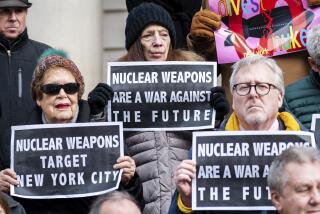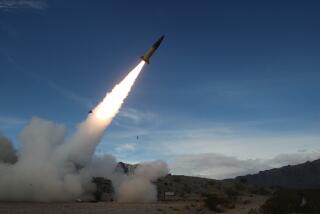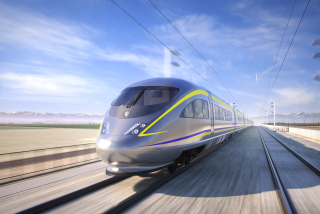A Good Place for Missiles Is an Obvious One: on Trains
- Share via
The Soviet Union’s SS-24 mobile intercontinental missile is being deployed (though it isn’t fully operational yet) on the nation’s rail system, a development that the Reagan Administration criticizes as a complication for arms control and a violation of the SALT II treaty--which the Administration itself has all but buried.
The most serious argument, made by Kenneth A. Adelman, the Administration’s arms-control director, is that rail-mobile missiles cannot be verified, located and counted, and hence make impossible an agreement to reduce the number of strategic ballistic missiles. In fact, rail-mobile ICBMs are distinctive enough to find with high confidence. Paradoxically, the bigger the rail-mobile missile, the more readily it can be dealt with in an arms-control agreement.
Those who argue against rail-mobile missiles raise these points: The missiles can roam all over the country, and they can be concealed in civilian-appearing trains or hidden in tunnels and buildings.
But rail-mobile missiles are just that--missiles confined to a nation’s rail net. Rail lines are easily recognized features when seen in aerial (and presumably satellite) photos. They point like engraved arrows at every possible place to which the missiles can go; trains cannot, after all, leave the tracks. The Soviet rail net is especially easy to inspect. It is a skeleton whose backbone is formed by the Trans-Siberian and Baikal-Amur rail lines stretching across seven time zones, but with few ribs running perpendicular to the spine.
Trains cannot be hidden in tunnels--they would block rail traffic--and construction of special tunnels would be observed.
Trains cannot circulate at random, but must follow schedules, particularly on a single-track main line like the Trans-Siberian, where trains going in opposite directions can meet only at sidings.
And rail lines seldom enter buildings; they stop at loading docks.
Despite Pentagon models of U.S. rail-mobile MX missiles concealed in ordinary boxcars, moving in ordinary freight trains, nobody is likely to deploy ICBMs that way. Nuclear missiles need an appropriate guard force. Since missiles cannot be fired and maintained on their own, a missile train will need cars for control mechanisms and crews, as well as for maintenance. Missiles, like cars, need regular inspection and major maintenance, so special-purpose garage and garrison facilities will be required.
Nuclear weapons, Soviet and American, will not be intermingled with ordinary freight cars. The missiles would be subject to mishandling and unavailability as the trains were shunted back and forth, coupled and uncoupled, in railroad yards. Missile trains will, in fact, be distinctive. They will be short, with four to eight cars--most of them armored, some oversized with recognizable equipment for erecting and firing their rockets. There must be a facility for placing missiles on rail cars. The heavier the missile, the more single-purpose such an installation will be. It will certainly be an unusual and identifiable site--particularly if rail-mobile missiles are in the MX or SS-24 class, weighing nearly 200,000 pounds. It is possible to estimate the number of missiles that the loading facility can process each week or month, and so to set an upper limit on the number of ICBMs in the force. An arms-control agreement could, and should, restrict the number of missile-handling facilities. Reasonable on-site inspection procedures could verify that no other buildings contained the necessary machinery for loading onto a railroad car the heavy nuclear weapons, high-explosive fuels and sensitive electronics that make up an intercontinental missile.
Finally, rail-mobile missiles are survivable. Communications with them can be made more secure and more rapid than with any other strategic weapons except vulnerable silo-based rockets. After all, the actual rails constitute a very rugged transmission line. In the United States the rails are often paralleled by fiber-optics communications systems, which are inherently resistant to nuclear effects. And, while intelligence can determine the number of rail-mobile ICBMs deployed, it cannot provide targeting information on those missiles from minute to minute.
For the United States, which presumably has no plans for a first strike, these are advantages. It is in our interest for the Soviet Union to know that its retaliatory missiles are safe, so that it is never tempted to preempt.
Rail-mobile strategic missiles make sense if the United States and the Soviet Union desire survivable intercontinental missiles. Instead of deploring Soviet deployments, perhaps we should get on with our own.
More to Read
Sign up for Essential California
The most important California stories and recommendations in your inbox every morning.
You may occasionally receive promotional content from the Los Angeles Times.









